1. INTRODUCTION
Traditional medicine is the total combination of knowledge and practices, whether explicable or not, used in diagnosing, preventing or eliminating a physical, mental or social disease and which may rely exclusively on past experiences and observations handed down from generations to generations, verbally or written. The practice utilizes vegetables, animals and minerals, and other methods [1]. Herbal medicines serve the primary health needs of about 80% of the world’s population, especially for people in the rural areas [2].
Medicinal plant as defined by World Health Organization is “any plant in which one or more of its parts contains substances that can be used for therapeutic purposes or which are precursors for the synthesis of useful drugs”[3]. Quite a number of medicinal plants discovered by herbal practitioners have proved to be important sources of potential therapeutic agents e.g. Quinine (antimalarial agent) from Cinchona bark, digoxin and digitoxin (cardiac activity) from Digitalis purpurea, zingiberone (anti-helmintic) from Zingiber officinalis [4]. Various factors can be attributed to the upsurge in the use of plant based remedies. They may include: Economic
considerations such as high cost of conventional medicines, perceived lower toxicity and fewer side effects of plant based medicines as these plants have been used before and the increased cases of drug resistance which are being encountered with the use of Conventional medicines have favorably contributed to the use of plant based remedies [5].
Inflammation (Latin, inflammatio), is defined as part of the complex biological response of vascular tissues to harmful stimuli, such as pathogens, damaged cells, or irritants [6]. Inflammation is a protective immunovascular response that involves immune cells, blood vessels, and molecular mediators [7. There are two types of inflammation; Acute and chronic inflammation. The classical signs of acute inflammation are pain, heat, redness, swelling, and loss of function [8]. Certain conditions, such as; rheumatoid arthritis, osteoarthritis, inflammatory bowel diseases, multiple sclerosis, psoriasis and atherosclerosis appears to have no resolution and a chronic state of inflammation develops that may last for the life of the individual [9].
Diodia sarmentosa is one of the medicinal plant which have enjoyed wide patronage among traditional medicine practitioners in the management of many conditions including inflammatory disorders. It becomes extremely important to establish its pharmacognostic standards and also establish scientific evidence of its use in the management of inflammatory conditions and disorders. Therefore, the search for newer, safer and more effective anti-inflammatory agents remains.
2. MATERIALS AND METHODS
Materials
Methanol, ethyl acetate, n- hexane, distilled water, iodinated zinc chloride, Molisch’s reagent, phloroglucinol, hydrochloric acid, Sudan red, ruthenium red, N/50iodine, 1-naphthol, 5%, , Ferric chloride, Sulphuric acid (Sigma-Aldrich, St. Lous, MO, USA), Anisaldehyde (Sigma-Aldrich, St. Lous, MO, USA), Aluminium chloride, Carageenan (Sigma-Chemical, St. Lous, MO, USA), Piroxicam (Pfizer, Pakistan), Normal saline, Hydrochloric acid, TLC silica gel 60 F254 pre-coated plates (Merk-Germany), Fehling solution A and B, sulphuric acid, 20% potassium hydroxide, chloroform, ammonia solution, benzene, acetic acid anhydride, glacial acetic acid, 3,5-Dinitrobenzoic acid, lead sub-acetate solution, metallic magnesium chips, Mayer’s reagent, Dragendoff’s reagent, Wagner’s reagent and 1% picric acid solution.
Plant collection and Authentication
The aerial part of Diodia sarmentosa was collected from Kakiyayi village, Sabon Gari Local Government Area, Zaria, Kaduna State in March 2018. The plant material was identified by a taxonomist Mallam U.S.Gallah at Basic and Scientific Department, Bio-Resource unit, National Research Institute for Chemical Technology (NARICT), Bassawa Sabo Gari, Zaria Kaduna. Where voucher specimen number of 1372 was deposited for future reference.
Macroscopic / Organoleptic Examination of Diodia sarmentosa
The macroscopic features of Diodia sarmentosa were examined using naked eyes and magnifying lens such as the leaf base, lamina, shape, venation, margin, apex, length and width of leaf, vein type, leaf texture, colour, stem color and texture, taste and odour.
Microscopic Examination of Diodia sarmentosa
The fresh leaves and stem of Diodia sarmentosa plant were cut into sections and mounted in dilute glycerol and observed under the light microscope using x40 objective lens as described by Evans [10].
Determination of Physicochemical Constants of Diodia sarmentosa
Moisture content (loss on drying), total ash, water soluble ash and acid insoluble ash values, extractive values (water and alcohol) of the plant sample was determined as described in World Health Organization guidelines on methods of evaluation of crude drugs.
Chemomicroscopic Examination of Diodia sarmentosa Powdered Sample
The chemomicroscopic evaluations of Diodia sarmentosa aerial part were carried out on the powdered sample to observe the presence or absence of cell walls materials and cell inclusions. The methods were carried out as described in World Health Organization guidelines on quality control methods for medicinal plant materials.
Phytochemical Screening of Diodia sarmentosa
The methanol and 70% methanol extracts were subjected to preliminary phytochemical analysis to test for the presence or absence of phytochemical constituents using standard methods [10-12].
Animals
Adult Wistar rats (150-200g) of both sexes were obtained from the animal house of the Department of Pharmacology and Therapeutics, Ahmadu Bello University, Zaria. The animals were maintained in a well-ventilated room in the laboratory animal house under ambient laboratory conditions. They were fed with laboratory feeds and water ad libitum and maintained under standard laboratory conditions.
Acute toxicity
The oral Median Lethal doses of the two (2) extracts of Diodia sarmentosa aerial part were estimated using Organization For Economic Cooperation and Development (OECD) 425 guideline [13].
Anti-inflammatory Studies
The method described by Winter et al., [14] was adopted in the study. Forty-eight (48) rats were fasted for 12 hours and randomly divided into 8 groups with each containing six rats. Group I, II and III received 200, 400 and 600 mg/kg of the 70% methanol extract, group IV, V and VI received 200, 400 and 600 mg/kg methanol extract, group VII received piroxicam 10 mg/kg (positive control) and group VIII were given normal saline (negative control). One hour later, 0.1ml of freshly prepared Carrageenan suspension (1% w/v in 0.9% normal saline) was injected into the sub planter region of the left hind paw of each rat. The paw diameter was measured with the aid of a vernier calliper at 0, 1, 2, 3, 4, 5 hours, after the injection of Carrageenan. The differences between the readings at time 0 hour and different time intervals were taken as the thickness of oedema.
3. RESULTS
Macroscopic and organoleptic evaluation of Diodia sarmentosa aerial part
Diodia sarmentosa aerial part was found to be dark-green in colour, tasteless, odourless, margin entire, charteceous texture, cuneate leaf base, apex acute, compound leaf type, leaf shape is ovate-lanceolate, reticulate veination and stem texture is pubescent. The average leaf length was 4.21cm ± 0.38 and the width 1.88 cm ± 0.22 as shown in Figure 1 and Table 1.
Microscopic features of Diodia sarmentosa aerial part
The microscopy of the upper and lower epidermal cells of the leaf showed wide variations in shape and sizes having Anomocytic type of stomata, polygonal to wavy epidermal cell shapes, guard cell being surrounded by four to five subsidiary cells and the cells of upper epidermis are polygonal while those of the lower epidermis are sinuous (Figure 2 and 3).
Transverse section of the leaf of Diodia sarmentosa
The outline of the transverse section of the leaf of Diodia sarmentosa through the midrib appeared convex on the abaxial and concave (hollow) at the adaxial surface. The cell walls are moderately thickened. It has non-glandular, unicellular and uniseriate bicellular covering trichomes at the abaxial surface. The vascular bundle is arc shaped which consists of the phloem and xylem (Figure 4).
Transverse section of Diodia sarmentosa stem
The transverse section of the stem of Diodia sarmentosa epidermis was found to be covered with thin cuticle. The cell wall is moderately thickened and the cortex consists of polygonal parenchyma cells. The phloem and xylem cells are arranged in groups and present in form of strands (Figure 5).
Quantitative Microscopy of the Leaf of Diodia sarmentosa
The quantitative leaf microscopic evaluation of the leaf of Diodia sarmentosa revealed the lower epidermal layer stomatal number to be 94.4 ± 3.84, stomatal index 19.35 ± 0.38, palisade ratio 9.70 ± 0.20, vein-let termination number 5.20 ± 0.83, and vein-islet number 8.80 ± 0.83 while in the upper epidermal layer the stomatal number was found to be 91.00 ± 2.28, stomatal index 18.35 ± 0.33, palisade ratio 7.00 ± 0.70, vein-let termination number 3.80 ± 0.37, and vein-islet number 6.60 ± 0.83 as seen in Table 2 below;
Chemomicroscopic Evaluation of Diodia sarmentosa Powdered Sample
The chemomicroscopy of the powdered aerial part of Diodia sarmentosa revealed the presence of some cell wall materials and cell inclusions such as seen in Table 3 below;
Physicochemical Constants of Diodia sarmentosa Aerial Part
The aerial part of Diodia sarmentosa evaluated for physicochemical parameters revealed the percentage moisture content to be (11.33%); total ash (11.00%), acid insoluble ash (1.50%), water soluble ash (5.20%), ethanol extractive value (11.67%) and water extractive value (13.67%) respectively as seen in Table 4 below;
Preliminary Phytochemical Screening of Diodia sarmentosa Aerial Part Extracts
The preliminary phytochemical screening of the methanol and 70% methanol extracts revealed the presence of carbohydrates, saponins, flavonoids, tannins, steroid/triterpenes, and cardiac glycosides. While alkaloids and anthraquinones were absence in both extracts as seen in Table 5 below;
Acute Toxicity Profile of Diodia sarmentosa Aerial Part Extracts in Rats
The acute toxicity study conducted according to Organization for Economic Cooperation and Development (OECD) guideline in rat (OECD Test Guideline 425, 2001) limit dose indicated no signs and symptoms of methanol and aqueous methanol extracts at 2000 mg/kg body weight. No change was observed in skin and fur, eyes and mucous membranes, respiratory and behavior pattern were observed and found to be absent. No tremors, convulsions, salivation, diarrhoea, lethargy, sleep and coma were observed to be absent.
Anti-inflammatory Activities of Diodia sarmentosa Aerial Part Extracts
The injection of 1% Carrageenan suspension in the left hind paws of the rats produced an oedema reaching its maximum at the third (3rd) hour. The methanol extracts of Diodia sarmentosa significantly inhibited the paw oedema at doses of 200, 400 and 600 mg/kg. While both extracts significantly inhibited the oedema at the 4th and 5th hour at all doses as shown in Table 6 below;
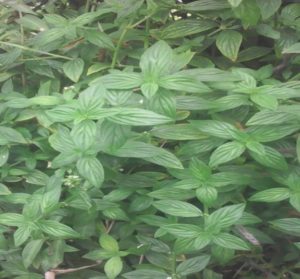
Click to view
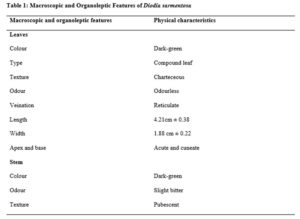
Click to view
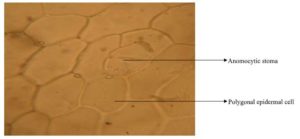
(Magnification X 160)
Click to view
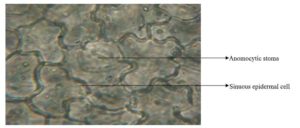
(Magnification X 160)
Click to view
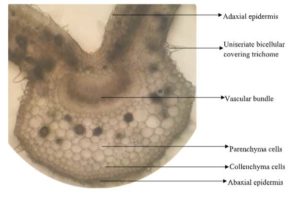
Click to view
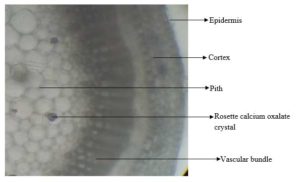
Click to view
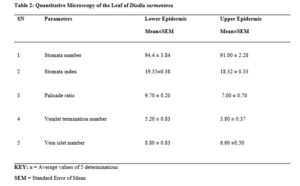
Click to view
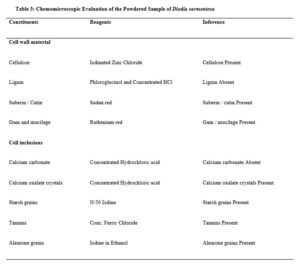
Click to view
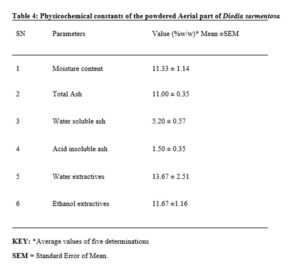
Click to view
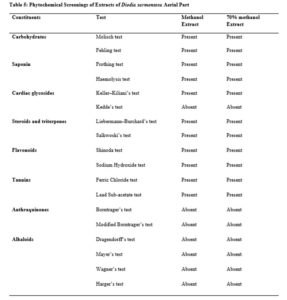
Click to view
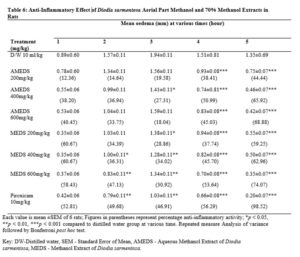
Click to view
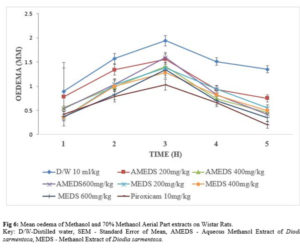
Click to view
4. DISCUSSION
Natural remedies obtained from medicinal plants are favourable choices over synthetically formulated drugs [15]. It is extremely important to individualize the consumption of herbal products not merely based on the knowledge of folklore use but through systematic studies [16]. Pharmacognostic, physicochemical and phytochemical evaluations are of robust entitlement of Diodia sarmentosa in the treatment of pain and inflammatory conditions such as swellings, bruises and minor cuts in context of its pharmaceutical and pharmacological importance [17].
Macroscopically, the present study revealed that Diodia sarmentosa is a scrambling perennial or annual herb of 1-4.5m long, often with many lateral branches from the main stem; which has an opposite leaf arrangement, the leaftlet average sizes were measured to be up to 4.21cm in height and 1.88cm in width. It has compound leaves, ovate to lanceolate in shape, reticulate venation, margin is entire, apex is acute, base is cuneate, texture is charteceous, dark-green colouration, tasteless, odourless. The stem is pubescent and slight bitter in taste. The morphological (macroscopic) and organoleptic observations made in this study are not different from the findings of Watson and Dallwitz [18] and Ibrahim [19].
Microscopic examination showed that the leaves of Diodia sarmentosa have some diagnostic features; stomata were found on both the adaxial and abaxial surface of the leaf and were identified to be anomocytic type of stomata, epidermal cells shows wide variations in shape and sizes. The cells of upper epidermis are slightly sinuous while those of the lower epidermis are sinuous. The observations are similar to that of Diodia scandens another species of genus Diodia belonging to the same family Rubiacieae [20].
Transverse section of the leaf of Diodia sarmentosa across the midrib showed that the leaf is dorsiventral with well-arranged vascular bundle and trichomes were present on the abaxial surface. This is a good distinguishing and diagnostic anatomical feature for the leaf because most dicotyledonous leaves are known to be dorsiventral [21].
The transverse section of the stem showed the epidermal cells, cortical cells and vascular bundles consisting of xylem and phloem. Most of the anatomical features of the stem in transverse section correlate with that of Metcalfe and Chalk [22], except the presence of crystals on the cortex region. The quantitative leaf microscopy of the lower epidermal layer showed the stomatal number (94.40 ± 3.84), stomatal index (18.22 ± 0.33), palisade ratio (9.70 ± 0.20), veinlet termination (5.20 ± 0.83) and vein islet number (8.80 ± 0.83) and the upper epidermal layer showed the stomatal number (91.00 ± 2.28), stomatal index (18.35 ± 0.33), palisade ratio (7.00 ± 0.70), vein-let termination number (3.80 ± 0.37), and vein-islet number (6.60 ± 0.83). The stomatal number varies considerably with the age of the leaf and due to changes in environmental condition; stomatal index is relatively constant and is of diagnostic importance for a given species. It is therefore, employed in the differentiation of closely related species of the same genus in air-dried and fresh conditions [23].
The physicochemical parameters evaluated include moisture content (11.33 ± 1.14), total ash value (11.00 ± 0.35), water soluble ash (5.20 ± 0.57), acid insoluble ash (1.50 ± 0.35), ethanol extractive values (11.67 ± 1.16) and water extractive values (13.67 ± 2.51) respectively. Physical constant parameters could be useful in detecting any adulterant in the drug. Musa et al., [24] reported that the result of the moisture content that is not high indicated less chances of microbial degradation of the drug during storage. The moisture content obtained in this study was 11.33% which indicates less chances of microbial degradation of the drug during storage. The general requirement of moisture content in crude drug is that, it should be within 12-14% [25]. The acid-insoluble ash 1.50% obtained in this study indicated that the plant was in good physiological condition and it contained little extraneous matter such as sand, silica and soil. The water soluble ash could be used to estimate the amount of inorganic compound present in the crude drugs. The water soluble ash 5.20% obtained in this study is in agreement with British Herbal Pharmacopoeia that have reported permissible limits of ash contents in crude drugs.
Extractive values determine the amount of the phyto-constituents in a given amount of plant material when extracted with a particular solvent. The extraction of any crude drug with a particular solvent yields a solution containing different phyto-constituents. The compositions of these phyto-constituents depend upon the nature of the drug and the solvent used [26]. The results of water and ethanol extractive values were 13.67% and 11.67% respectively; this implies that extraction of Diodia sarmentosa aerial part with water will extract more constituents than ethanol. This conformed to the previous findings of [27] who revealed that having higher water extractive value implies that water is a better solvent of extraction than ethanol.
Chemomicroscopical features of the powdered sample of Diodia sarmentosa revealed some cell inclusion and cell contents materials. These include cellulose, mucilage, starch, tannins, suberins, aleurone grains, mucilage and calcium oxalate crystals. While Calcium carbonate and lignin were absent.
The preliminary phytochemical screening revealed the presence of carbohydrate, cardiac glycosides, saponins, flavonoid, steroids and triterpenes in the methanol and 70% methanol extracts. Alkaloids and anthraquinones were absent in both extracts. The presence or absence of phytochemical constituents especially the secondary metabolites serves as useful taxonomic key in identifying a particular species and distinguishing it from related species [28].
Following the administration of 2000mg/kg of the dose extract to each group of rats, the animals were observed for physical signs of toxicity such as decreased locomotion, tremor, loss of body posture, convulsion and death. The median lethal dose (LD50) was 2000 mg/kg suggesting that the extracts are relatively safe [29].
Carrageenan-induced inflammation is an acute test and is widely used as a model for the evaluation of anti-inflammatory activity of drugs. The mechanism of action of carrageenan-induced inflammation involves two distinct phases; the first phase is associated with the release of histamine, serotonin and kinins in the first hour; while the second phase is associated with the release of prostaglandins and lysosome enzymes in the second to third hour [30].
Non-steroidal anti-inflammatory drugs such as indomethacin, aspirin, piroxicam and diclofenac are the conventional drugs used to manage inflammation [31]. The anti-inflammatory effect of NSAIDs is attributed to their inhibitory effect on the activity of COX-2 enzyme that converts arachidonic acid to the inflammatory mediator prostaglandins [32]. The phytochemical screening of the aerial part methanol and 70% methanol extracts of Diodia sarmentosa revealed the presence of flavonoids, saponins, tannins, cardiac glycosides, steroids and triterpenes in the extracts. Some of these could have been responsible for its anti-inflammatory activity, moreover, flavonoids and saponins are known to possess analgesic and anti-inflammatory properties due to their inhibitory effects on enzymes involved in the production of the chemical mediators of inflammation [33].
5. CONCLUSION
The aerial part of Diodia sarmentosa possesses important diagnostic features that could be used as a basis for identification and authentication of the plant. The methanol and 70% methanol extracts of the aerial part of Diodia sarmentosa contain bioactive constituents with anti-inflammatory activities, and further support the ethnomedicinal claim of the use of the plant in the management of inflammatory conditions.
REFERENCES
- World Health Organization, (1998). Guidelines for the appropriate use of herbal medicine, pp 1– 88.
- Rajadurai, V. G., Vidhya, M., Amya, R.. and Anusha Bhaskar. (2009). Ethno-medicinal Plants Used. World health organization (2003). fact sheet no 13 revised May 2003.
- World Health Organization, (2011). Quality Control Methods for Medicinal Plants. WHO, Geneva, Switzerland, Pp. 31.
- Hardman, R. (1991). Progress on medicinal plants. The pharmaceutical Journal, 247:540-542.
- Abdullahi, A. A. (2011) Trends and challenges of traditional medicine in Africa. African Journalof Traditional and Complementary and Alternative Medicine. 8, 115–
- FerreroMiliani, L., Nielsen, O. H., Andersen, P. S. and Girardin, S. E. (2007).Chronic inflammation: Importance of NOD2 and NALP3 in interleukin-1β generation. Clinical and Experimental Immunology, 147: 227-235.
- Bairy, K. L., Chogtu, B. and Nayak, V. (2015). Effect of fluticasone propionate with biopolymer on skin inflammatory model in wistar rats. Research Journal of Pharmaceutical, Biological and Chemical Sciences, 6: 721-723.
- Abbas, A. B. and Lichtman, A. H. (2009). Innate Immunity In Saunders (Elsevier). Basic Immunology. Functions and disorders of the immune system, 3rd edition. ISBN 978-1-4160-4688-2.
- Neville, A. P. Cliff, J. W. and Ian, A. (2004). Journal of Inflammation, http://www.journalinflammation.com/content/1/1/1.
- Evans, W. C. (2009). Trease and Evans’ Pharmacognosy, 16th Edition. Saunders Elsevier Toronto, Canada. pp. 1 -9, 26, 225, 252, 304, 356, 437-440. Doi: http://tiny.com/3878b3.
- Sofowora, S.A. (2008). Medicinal Plants and Traditional Medicine in Africa. Spectrum Book Limited, Nigeria. pp. 142-145.
- Shah, B. N. and Seth, A. K. (2010). Medicinal plants as a source of anti-pyretic agent a – review. Archives of Applied Science Research, 2(3), 188 – 195.
- Organisation for Economic Cooperation and Development, OECD (2001). Guidance document on acute oral toxicity testing. Guideline 425.
- Winter, C.A. Riselay, E.A. and Nuss, G.W. (1962) Carrageenan induced oedema in the limb paw of the rats as assay for anti-inflammatory drugs. Proceedings of the society for experimental biology and medicine, 111(3), 544-547. World Health Organisation, 81: 646–
- Ishtiaq, S., Meo, M. B., Afridi, M. S. K., Akbar, S. and Rasool, S. (2016). Pharmacognostic studies of aerial parts of Colebrookea oppositifolia Annals of phytomedicine, 5, (2):161 – 167.
- Dewick, P. M. (2002). Medicinal Natural Products: A biosynthetic approach. III Edition. John Wiley and Sons, New York, U.S.A., pp: 2-5.
- Panda, H. (2004). Handbook on herbal drugs and its plant sources. National Institute of Industrial Research, Delhi, India, pp: 4.
- Watson, L. and Dallwitz, M. J. (1992). The families of flowering plants. Description, illustration, identification, information retrieval version, 25th November 2009.
- Ibrahim, K. R. (2005). Plant Anatomy. Chand and Company Limited, Ram Nagar, New Dehi, 110044: 409p.
- Essiett, U. A., Bala, D. N., and Agbakahi, J. A. (2010). Pharmacognostic studies of the leaves and stem of Diodia scandens in Nigeria. Archives of Applied Science Research, 2(5):184-198.
- Dutta, A. C. (2003). Botany for Degree Students. 6th Edition Oxford University press, London, U.K., P 532.
- Metcalfe, C. R., and Chalk, L. (1979). Anatomy of Dicotyledons, Second Edition, Vol. 1, Clarendon Press, Oxford.
- Kokate, C. K., Purohit, A. P and Gokhale, S. B (2009). Pharmacognosy. 43rd Pune: Niralli Parakashan; Pp.6.17 – 6.20.
- Musa, K. Y., Katasayl, U. A., Abdrahman, E. M., Ashok, M. B. and Abubakar, M. S. (2005). African Journal of Pharmaceutic Research Development, 2(1): 79 – 83.Ibrahim, K. R. (2005). Plant Anatomy. Chand and Company Limited, Ram Nagar, New Dehi, 110044: 409p.
- British Herbal Pharmacopoeia, (1990). British Herbal Medicine Association. Bournemouth: Dorset. 1st edition. Vol.1. Pp. 1-2.
- Tatiya, A, Surana, S, Bhavsar, S, Patil, D, Patil, Y. (2012).Pharmacognostic and preliminary phytochemical investigation of Eulophia herbacea Tubers (Orchidaceae).AsianPacific Journal of Tropical Disease; 2 (1): pp: 50-55.
- Ajazuddin and Shailendra S. (2010). Evaluation of physicochemical and phytochemical properties of Safoof-E-sana, a Unani polyherbal formulation. Journal of Pharmacognosy Research 2(5): 318-322.
- Jonathan, G. and Tom, J. M. (2008). Secondary metabolites and the higher classification of angiosperm. Department of Botany, University of Texas, Austin, TX 78712, USA. Nordic Journal of Botany (Impact Factor: 0.6). 03/2008; 5 – 34.
- Matsumura, F. (1975). Toxicology of Pesticides. New York and London. Plenum Press. Pp. 22 -26.
- Thomazzi, S. M., Silva, C. B., Silveira, D. C. R., Vasconcellos, C. L. C., Lira, A. F. and Cambui, E. V. F.(2010). Antinociceptive and anti-inflammatory activities of Bowdichia virgilioides (sucupira). Journal of Ethnopharmacology, 127: 451-456.
- Mwangi, B. M., Gitahi, S. M., Njagi, J. M., Mworia, J. K., Aliyu, U., Njoroge, W. A. and Mburu, N. D. (2015). Anti-inflammatory Properties of Dichloromethane: Methanolic Leaf extract of Caesalpinia Volkensii and Maytenus Obscura in Animal Models. International Journal of Current Pharmaceutical Research, 7: 83-87.
- Shukla, S. and Mehta, A. (2015). In vivo anti-inflammatory, analgesic and antipyretic activities of a medicinal plant, Caesalpinia bonducella F. Pakistan journal of pharmaceutical sciences, 28 (4), 1517-1521.
- Kaushik, D., Kumar, A., Kaushik, P. and Rana, A. C. (2012). Analgesic and anti-Inflammatory Activity of Pinusrox burghii Sarg. Advanced Pharmacology Science 6.
